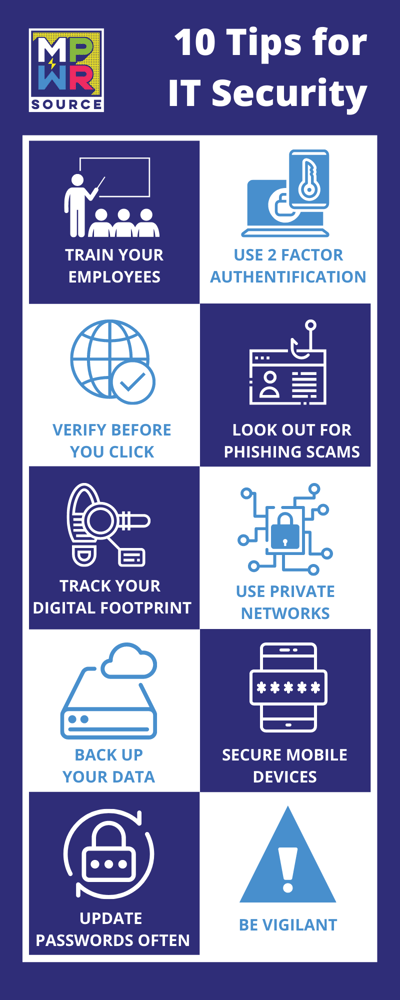The internet can be the wild west, with the threats of malware, ransomware, worms, and phishing scams at seemingly every junction. Security breaches and data leaks are becoming more frequent, and so we decided to round up our top ten tips to help your organization maintain its IT security.
TOP TEN TIPS FOR IT SECURITY
1. TRAIN YOUR EMPLOYEES!
Education is the best defense against cyber-attacks and hacking. Make sure that your employees know how the bad actors work and are aware of things like social engineering. Social engineering involves tactics of deceit and impersonation to gain access or information, such as fake email addresses or websites that “appear” legitimate and thereby get victims to volunteer their sensitive data. They should also be wary of phishing scams which are prevalent. The human element is oftentimes the weakest link in a network, but it can and should be your greatest asset.

pim offers phishing campaigns to test your employees and help keep your network secure in their business IT solutions (bits) package.
2. TWO FACTOR AUTHENTICATION
Two factor authentications may seem like a hassle, but it provides two layers of security. This way if a hacker somehow has access to your password, there is still an additional security measure in place to ensure that your data remains secure.
3. VERIFY BEFORE YOU CLICK
Because today’s hackers are so savvy, oftentimes their emails with malicious links look legitimate. If an email looks suspicious, it usually is. Does your CEO usually email you about her favorite weight loss tips? Probably not. One way to combat this trick is to check with the sender if they really did send you that You Tube video about rapid keto diets.
 4. BE ON THE LOOKOUT FOR PHISHING SCAMS
4. BE ON THE LOOKOUT FOR PHISHING SCAMS
Phishing is the fraudulent practice of sending emails purporting to be from reputable companies in order to induce individuals to reveal personal information, such as passwords and credit card numbers. You can and should deploy a strong anti-phishing to catch/filter phishing emails before they even reach their intended recipients.
5. KEEP TRACK OF YOUR DIGITAL FOOTPRINT
Keep an eye on all of your accounts so that you can catch suspicious activity. It is important to keep track of all of the places that your sensitive information, including social media, delete the accounts you are not using, be careful where you store your credit card information, and make sure that you set strong passwords.
6. USE PRIVATE NETWORKS WHEN POSSIBLE
Would you open up your private information on a computer whose monitor is the jumbotron in Times Square? Of course not. When you work on an unsecured connection, anyone can access your information. Only connect to private networks whenever possible, especially when handling your company’s sensitive information.
7. KEEP UP TO DATE BACK UPS OF IMPORTANT DATA
There is no excuse to not back up your important data. Back it up on a physical location and on the cloud. Oftentimes, threats don’t want to just steal your data, but to encrypt it or erase it. Having an up to date back up of all of your information is the ultimate recovery tool.
8. SECURE YOUR MOBILE DEVICES
Security doesn’t end at your desktop. Make sure your employees secure them with a password or fingerprint scanner, keep them up to date, backup data on the phone, be wary of connecting to public WiFi.
9. UPDATE YOUR PASSWORDS OFTEN
One of the easiest ways hackers get your information is by getting a batch of usernames and password combinations from one source and trying those same combinations elsewhere. For example, if your Target account gets hacked and it is the same password you use for your banking, your work log-in, and your Hello Fresh account, you should assume that all of those accounts are now hacked. By having individual passwords for every account, you can prevent a domino effect of data breaches. Remember the adage: Passwords are like underwear. Don’t share them and change them often.
10. BE VIGILENT AND LOOK FOR VULNERABILITIES
It’s said that in terms of hacking, there are three types of businesses: those that have been hacked, those that will be hacked, and those that don’t know that they’ve been hacked. The most dangerous thought an organization could have would be to think that hacks and data breaches cannot happen to them.
pim's system management services can help you achieve maximum computer-system productivity while reducing the burden of day-to-day IT management by guarding against cyber threats, protect critical data, and support business continuity. pim utilizes anti-virus, patching, monitoring services, and remote assistant tools to help keep your IT secure.